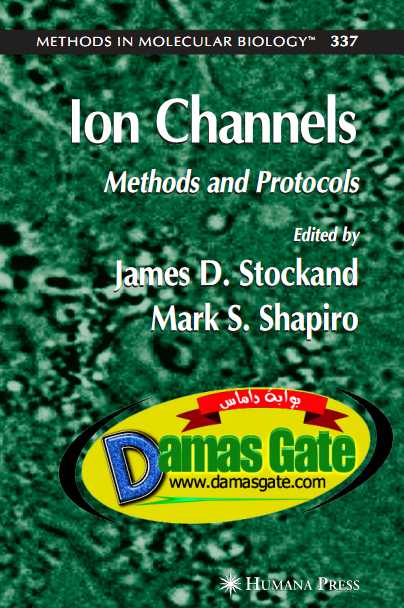Ion Channels: Methods and Protocols
James D. Stockand,

Preface
Research on ion channels has exploded in the last few decades and it is now
clear that ion channels play essential roles in cell biology and physiology, with
their dysfunction being the root cause of many human diseases. Understanding
human biology in the post-genome sequencing era requires that the function of
the protein products encoded by these recently sequenced genes be quantified.
Using contemporary tools and new experimental approaches, scientists interested
in ion channels are in the unique position of being able to directly, and often
in real-time, measure ion channel activity, subunit stoichiometry, structure–function
relationships, as well as many other biophysical/biochemical
parameters regarding a channel of interest. Development and application of
these experimental tools has led to a boom in investigation of ion channels;
however, as in many fields of research, wide implementation of the newest
technological advances lags well behind the discovery of these advances. We
believe that recently developed technologies useful for studying ion channels
have matured enough to where they should now be readily available to any
interested scientist. Ion Channels provides a comprehensive and detailed
description of recent technological breakthroughs and experimental designs used
to successfully study ion channels.
We write Ion Channels with the hopes that it will provide insight into rational
experimental design and the practical application of methodologies for research
on ion channels. The book is designed as a guide to facilitate emerging scientists
and young investigators beginning to establish their independent laboratories.
In addition, the established investigator whose research has recently directed
them towards the study of ion channels will find the book useful. This edition
also details several recent methodological breakthroughs with respect to
study of ion channels that the established ion channel investigator will find
useful. Finally, this edition will serve as a general and hopefully handy
resource with respect to practical application of diverse experimental approaches
for studying ion channels. It is our goal that this edition will provide
scientists the wherewithal to implement new research strategies and methods
into their research programs.
Internationally recognized biomedical scientists describe recent technological breakthroughs and demonstrate their use in successful experimental designs. The diverse applications range from the study of allosteric regulation of ion channel activity using a classic mutagenesis approach, to the study of channel subunit stoichiometry using a novel biophysical approach based on fluorescence resonance energy transfer. Highlights include methods for heterologous expression of ion channels in cells, for determining channel structure-function, for studying channel regulation and physiological function, and for genetic screening and investigating channelopathies.
ISBN: 1588295761 -- edition 2006 -- PDF -- 226 pages -- 4 mb
Download
*
James D. Stockand,

Preface
Research on ion channels has exploded in the last few decades and it is now
clear that ion channels play essential roles in cell biology and physiology, with
their dysfunction being the root cause of many human diseases. Understanding
human biology in the post-genome sequencing era requires that the function of
the protein products encoded by these recently sequenced genes be quantified.
Using contemporary tools and new experimental approaches, scientists interested
in ion channels are in the unique position of being able to directly, and often
in real-time, measure ion channel activity, subunit stoichiometry, structure–function
relationships, as well as many other biophysical/biochemical
parameters regarding a channel of interest. Development and application of
these experimental tools has led to a boom in investigation of ion channels;
however, as in many fields of research, wide implementation of the newest
technological advances lags well behind the discovery of these advances. We
believe that recently developed technologies useful for studying ion channels
have matured enough to where they should now be readily available to any
interested scientist. Ion Channels provides a comprehensive and detailed
description of recent technological breakthroughs and experimental designs used
to successfully study ion channels.
We write Ion Channels with the hopes that it will provide insight into rational
experimental design and the practical application of methodologies for research
on ion channels. The book is designed as a guide to facilitate emerging scientists
and young investigators beginning to establish their independent laboratories.
In addition, the established investigator whose research has recently directed
them towards the study of ion channels will find the book useful. This edition
also details several recent methodological breakthroughs with respect to
study of ion channels that the established ion channel investigator will find
useful. Finally, this edition will serve as a general and hopefully handy
resource with respect to practical application of diverse experimental approaches
for studying ion channels. It is our goal that this edition will provide
scientists the wherewithal to implement new research strategies and methods
into their research programs.
Internationally recognized biomedical scientists describe recent technological breakthroughs and demonstrate their use in successful experimental designs. The diverse applications range from the study of allosteric regulation of ion channel activity using a classic mutagenesis approach, to the study of channel subunit stoichiometry using a novel biophysical approach based on fluorescence resonance energy transfer. Highlights include methods for heterologous expression of ion channels in cells, for determining channel structure-function, for studying channel regulation and physiological function, and for genetic screening and investigating channelopathies.
ISBN: 1588295761 -- edition 2006 -- PDF -- 226 pages -- 4 mb
Download
*